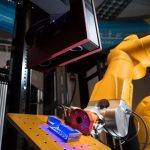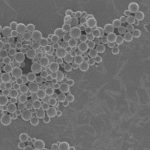DOE to deploy Arm-based supercomputer prototype at Sandia
Arm microprocessors have been used in numerous applications from vehicle computers to cell phones, but until recently, have not been practical for use in high-performance computing. Astra — one of the first supercomputers to use Arm processors in a large-scale high-performance computing platform — is expected to be deployed at Sandia later this summer.
Sandia’s robotic work cell conducts high-throughput testing ‘in an instant’
With 3D printing, you can make almost anything in a matter of hours. However, making sure 3D-printed parts work reliably takes weeks or even months. To speed up the process, Sandia scientists have designed and built a six-sided work cell around a commercial robot that conducts high-throughput testing to quickly determine how well those parts perform.
A splash of detergent makes catalytic compounds more powerful
Uniform catalytic compounds produced at Sandia don't just look nice, they outperform commercial varieties used as catalysts in solar cells and which could be used to produce clean-burning hydrogen fuel. If developed for industry, the new technology could improve performance while reducing costs of catalysts used everywhere from environmental cleanup to cancer treatment.
Sandia scores Innovation award
When it comes to promoting entrepreneurship and innovative technologies, Sandia stands out. That’s according to the Innovation Tri-Valley Leadership Group, which has honored the Labs with its prestigious 2018 Founders Award.
First wind blade from a 3-D printed mold, energy-saving nanoparticles earn Sandia national FLC awards
Sandia’s energy-saving nanomaterial window films and first wind turbine blades made from a 3-D printed mold earn national honors from the Federal Laboratory Consortium
Exploring Arctic clues to secure future with new Sandia, university partnership
The Arctic is undergoing rapid change, with sea ice melting and temperatures rising at a faster pace than anywhere else in the world. Understanding these changes is crucial for shaping and safeguarding U.S. security in the future, say Sandia scientists.
Exascale
The Energy Exascale Earth System Model, or E3SM, is an earth modeling system developed by eight DOE labs and several universities working under the aegis of DOE's Office of Science. It is expected to have one of the finest resolutions ever achieved by supercomputers simulating aspects of the planet’s climate.
Using biomimicry to detect outbreaks faster
Using biomimicry to detect outbreaks faster
A greater chance to thrive
5 percent pricing preference gives bidding advantage to NM small businesses
A project management jobs pipeline
Sandia, University of New Mexico agreement supports creating a Master of Science degree in project controls, project management, and program management









